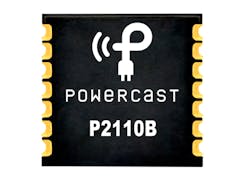>> Website Resources
.. >> Library: TechXchange
.. .. >> TechXchange: Power Management
.. .. .. >> Topic: Energy Harvesting
Download this article in PDF format.
Electronic devices are insinuating themselves further into everyday lives, and, of course, they all require power in some form to continue working. Fortunately, energy is all around us in many forms. Power can be converted from wind, light, objects in motion, even by tapping the leftover energy from high-frequency radio transmissions. As the world becomes more electronic in nature, it makes more sense to reuse energy when available, such as in RF/microwave signals, to establish more-efficient overall energy use.
Energy harvesting is probably best known for applications that start with the sun as the source of the energy. Especially for devices that require only small amounts of power for operation, light from the sun can be converted to enough dc voltage using relatively small solar panels.
In sparsely populated areas, it’s common to see the roofs of single-residence homes covered with enough solar panels to provide a significant source of energy as a backup or replacement for a local energy utility company. Similarly, in areas where open plains provide exposure to relatively high winds, such as the Midwest United States, it’s not unusual to see wind turbines that can convert the wind into “almost free” sources of electrical energy.
Today, sunlight is probably the most popular source of power that can be converted into dc voltage, with companies such as Analog Devices, Silicon Laboratories, and Texas Instruments offering extensive lines of solar-powered wireless transceivers, oscillators, and other high-frequency components. In addition, EnOcean has developed a series of self-powered switches that draw their power from solar sources, as well as many ICs that use wireless communications at ISM frequencies to perform solar-powered electronic functions. The most recent arrival is a solar-powered occupancy sensor for Bluetooth lighting-control systems, using Bluetooth Low Energy (BLE) to simplify in-building automation.
Not as widespread, but quickly growing in popularity, is the process of harvesting energy from RF/microwave signals, such as from radio/television broadcast stations and wireless equipment. Harvesting energy in this manner makes it possible to replace batteries in low-power applications, such as Internet of Things (IoT) sensors and radio-frequency-identification (RFID) tags. Reusing the energy can cut operating costs and improve the efficiency of existing electronic systems and devices.
Harvesting energy from RF/microwave signals is a clear-cut process. It can be performed with integrated circuits (ICs) containing basic components like radio receivers and boost converters that convert RF signal energy from an antenna to ac or dc voltage and then transfer the energy to a storage device, such as a rechargeable battery or capacitor. Straightforward Vivaldi antenna designs (see “Design an X-Band Vivaldi Antenna”) have shown excellent capability in providing ultrawideband (UWB) frequency coverage (e.g., 100 MHz to 6 GHz) in support of many RF energy-harvesting ICs.
Converting RF Energy
Commercial RF energy-harvesting receivers like the P2110B Powerharvester from Powercast Corp. provide the capability to convert RF signals to dc voltage (see figure). It’s a receiver designed for use in the lower portion of the industrial, scientific, and medical (ISM) band (902 to 928 MHz).
This surface-mount package holds the P2110B Powerharvester, an RF energy-harvesting IC that converts ISM signals from 902 to 928 MHz to dc voltage. (Courtesy of Powercast Corp.)
With the aid of an antenna, the P2110B can process RF input levels from −12 to +10 dBm, convert them to a dc voltage, and store the energy in a capacitor for use as needed. This low-level sensitivity allows for effective energy harvesting even at considerable distances from an RF source. The compact device is an example of currently available RF energy-harvesting technology that enables power management of small electronic products without a battery.
The P2110B uses its internal capacitor as part of its own controlled energy-conversion process. Regulated voltage levels from the energy harvester can be set from +2.0 to +5.5 V dc at maximum current of 50 mA. The output voltage flows once a high charge threshold is met on the capacitor. When the energy stored within the capacitor drops to a low-voltage threshold, the output voltage from the P2110B is turned off. As the manufacturer suggests, a microprocessor can be used with the energy harvester to optimize power usage and improve the performance of connected electronic devices, such as sensors.
Given the expected rapid growth of wireless IoT sensors and the need for remote wireless sensors in 5G cellular networks, energy harvesting will no doubt take many forms, including from photovoltaic and thermoelectric sources. One such example is an IC for harvesting energy from photovoltaic sources. The AEM10940 from e-peas semiconductors, developed for use with solar panels, can supply two independent regulated voltages to extend battery lifetimes or even eliminate the need for a battery in an electronic system.
More recently, the same firm developed a pair of semiconductor devices, models AEM30940 and AEM40940, for extracting energy from RF sources. Both feature integrated boost converters that supply charge to batteries and capacitors, and are designed to extract energy from low-power ISM-band signals. The AEM30940 can work with RF input levels as low as −18.2 dBm from 863 to 868 MHz and 915 to 921 MHz, −14 dBm from 2110 to 2170 MHz, and −9.5 dBm from 2.4 to 2.5 GHz. The surface-mount device features configuration pins to simplify implementation of different operating modes, and has low- and high-voltage package pins to supply a full range of voltages from 50 mV to 5 V.
The AEM40940 extracts ac power from RF signal sources, producing two independently regulated output voltages. It integrates a low-power rectifier and a boost converter in a plastic quad flatpack housing measuring just 5 ×5 mm. It’s usable at ISM frequencies of 868 MHz, 915 MHz, and 2.45 GHz, and input power levels of −20 to +10 dBm. The RF energy harvester features relatively high overall efficiency (measured from input port to output of the boost converter)—typically better than 20% for input power levels of −20 to 0 dBm at 868 and 915 MHz and typically better than 10% for input power levels of −10 to +5 dBm at 2.45 GHz.
Energy-harvesting devices are currently available for many different sources of power, including sunlight, wind, motion, temperature, even for capturing micropower from a user’s body heat. The capabilities vary for each harvesting approach, with solar power still the most popular and efficient form of harvesting energy already in the environment. But with the worldwide spread of wireless communications devices and the increase of RF/microwave signal energy in most populated areas, opportunities are growing for RF energy-harvesting technology as a means of running low-power electronic devices, such as the billions of IoT sensors expected to blanket the planet in the years to come.
>> Website Resources
.. >> Library: TechXchange
.. .. >> TechXchange: Power Management
.. .. .. >> Topic: Energy Harvesting


